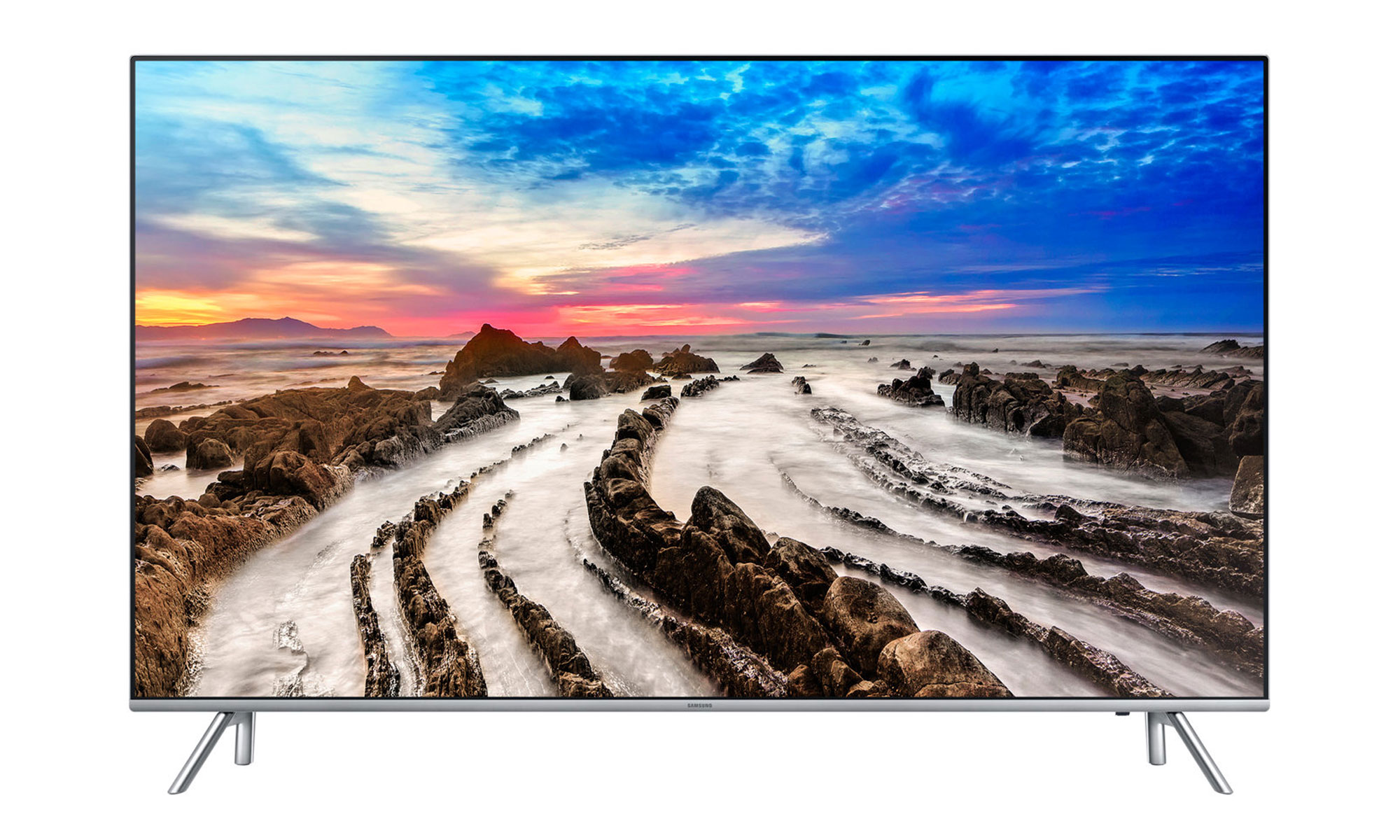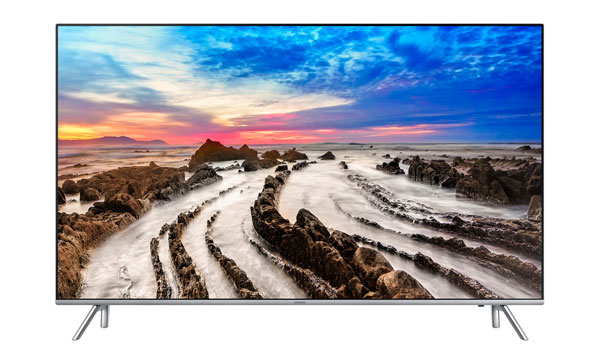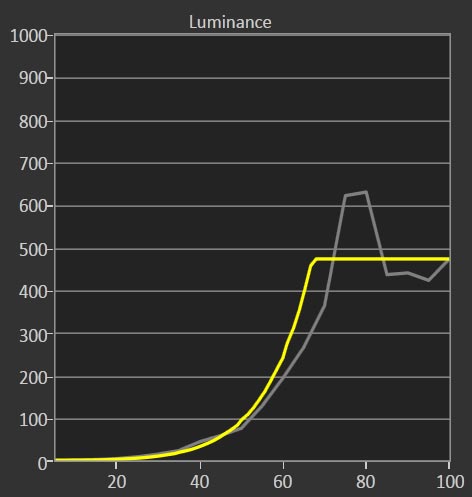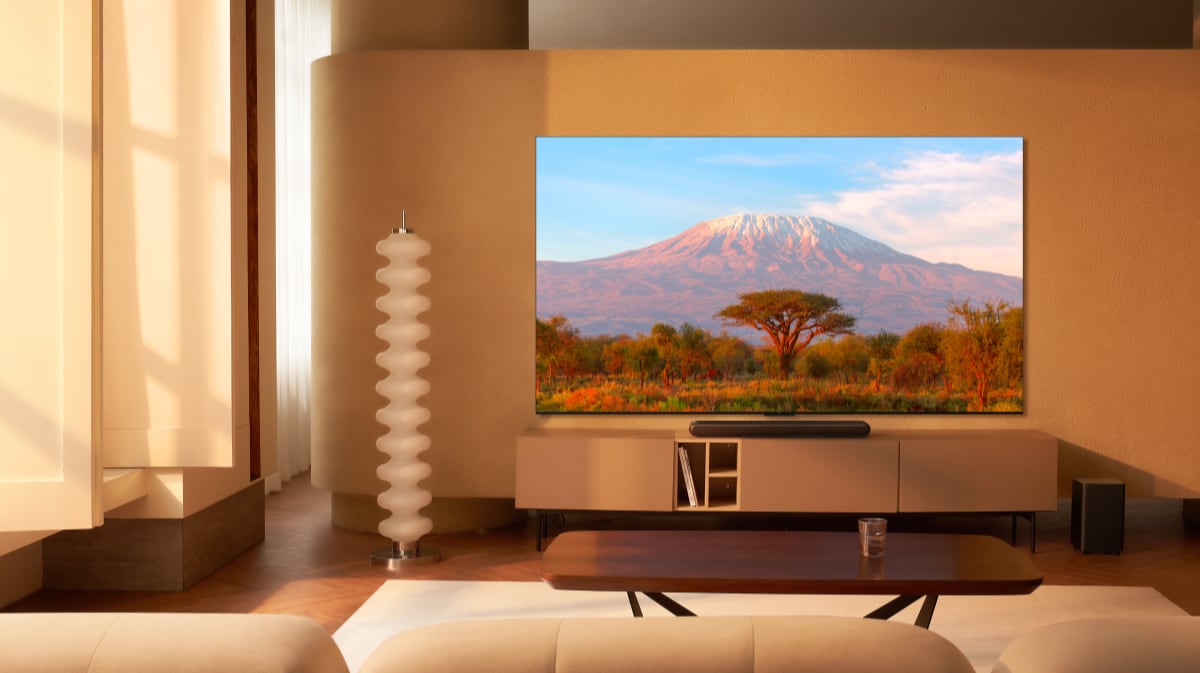Review: Samsung MU7000
Samsung’s TV line-up for 2017 is extensive, to say the least. The company has isolated its quantum dot-enhanced LCD TVs in the ”QLED” line and removed quantum dots from the rest of the line-up. So while MU range at first glance looks like the successor to last year’s KS range, it is in fact a more affordable mid-range TV with 4K resolution, HDR support, and the latest version of Tizen.
So how does MU7000 compare to other mid-range TVs? And to what degree is picture quality affected by the missing quantum dot film? Let’s find out.
Note that there are some differences in design and functionality between the European version of MU7000 and the US version. Picture quality should be roughly identical on MU7000 and MU8000, regardless of your region. We have tested the European version.Price and retailers:
Specifications
55" Ultra HD (3840x2160)
HDR10, HDR10+ & HLG
DCI-P3 color spaceVA LCD with edge LED Stand (fixed)
Wall (VESA 200x200)(HxWxD) 71.0 x 122.6 x 5.5 cm (without stand) 17.4 kg (without stand) 4x HDMI (4x 2.0)
3x USB
Ethernet
1x CI+Optical
HDMI-ARC
Headphones2.0 stereo (40W) DVB T/T2/C/S2
WiFi (ac standard)MPEG4
HEVC
VP9 Profile2Tizen 3.0 Bluetooth remote
Remote smartphone appManual
Remote controlSubscribe to our Newsletter, Facebook, twitter or RSS to receive notice when new reviews are publishedFirst impressions
Samsung MU7000 is a pretty looking TV that should blend in in most living rooms. How the feet look will depend on your region but the European version has two legs that you can fit in either a wide or more narrow position, the latter ensuring that the TV can fit on most furniture.
The speakers are hidden so the TV looks like most other models today. It is a big black surface surrounded by a thin metal bezel and a slightly taller bottom bezel. It is minimalistic and the wedge-shaped back makes it look thinner than it actually is. Compared to some of the OLED TVs that we were testing at the same time, MU7000 looks significantly more bulky but on the other hand it does not have a disfiguring electronics box mounted on the lower half. The back looks clean and pleasing to the eye.
For a few years now, Samsung TVs have come bundled with am external connection box for the most essential ports. The same is true for this year’s TVs. However, it is worth pointing out that not all ports are included here. Behind a compartment on the left side you will find LAN, 1x USB, and the CI port. You also need to connect power and of course the external connection box to the TV. These two cables can be hidden inside a small chamber in the center, which is a neat detail. You can even route the cables down through the right foot for a very clean and streamlined look.
We like Samsung’s decision and the external box but we hope that the company will start moving all ports into the external connection box in the future and the fact that the TV requires both power and data via two cables is a problem that Samsung has yet to solve.User experience & features
Since Samsung MU7000 runs Tizen 3.0 just like the more expensive “QLED” LCD models, we will not go over everything again. We instead refer to our review of Samsung Q9 for more details. Tizen works and looks the same. The only significant differences are that MU7000 does not come with Samsung’s premium remote that we liked a lot and that the processor is slightly less powerful.
Instead, MU7000 comes bundled with a black clicker made from matte plastic. It is built on the same concept, which is to remove most of the legacy buttons from the remote to gain more intuitive navigation. It mostly works, unless you are still a heavy user of broadcast channels. It is a TV remote designed for a world of apps and streaming. We like it.
Despite being a cheaper plastic remote, we should be quick to note that Samsung’s remote still trumps most other TV remotes today. It has some weight to it and fits nicely in my hand, and paired with the Tizen user interface it feels like a step or two in the right direction.
The built-in speakers in MU7000 are not great but better than we had feared. Despite being hidden behind the TV, the bass is good enough for casual viewing, forming a bottom in the sound space. Voices can sound somewhat trapped but not more than on most other mid-range TVs. For movies and TV series, we would recommend a soundbar or some external sound solution.
Like other Samsung TVs, MU7000 has a semi-glossy panel coating, which reflects light. It is designed to maintain intensity in colors and contrast in in bright living room environments but compared to OLED panels that use a similar type of coating, some light bounces around between the layers inside the LCD panel, which can negatively affect contrast somewhat in very bright living environments.Calibration
Samsung, the world’s largest TV manufacturer, knows a thing or two about picture quality, which is exactly why it bothers me that every time I turn on one of their TVs, the default picture settings are truly horrible; added sharpness, extremely oversaturated and cold colors, weird motion artefacts etc. Like most other manufacturers, Samsung insists that colors appear wildly inaccurate, even pulling content created in a smaller color space into a much larger color space (typically the native color space of the panel), which is very bad practice. I know why they do, I just don’t understand it. Is the mission to sell as many TVs as possible into the retail stores? Or is it to have satisfied end users?
MU7000 is, of course, no different so I quickly switched to ’Movie’, which is far more accurate and reproduces content in the correct color gamut. Based on the ’Movie’ mode a calibration requires far fewer steps and you can get decent picture quality with fairly accurate colors even without knowing anything about calibration to start with.
There are a few things that we would like to add. First of all, deactivate the ’HDR+’ option in the menu and never touch it again. HDR upscaling is even more horrible than the default color settings. Another thing; dynamic dimming cannot be completely turned off on Samsung’s most recent TVs but the effect on MU7000 is a lot milder than on the Q9 flagship. However, it complicates picture calibration. We prefer to turn off Samsung’s motion system as it very quickly introduces artefacts and the ”soap opera” effect.
After calibration we saw a drop around IRE 15-35, which could not be fixed without taking the more advanced calibration options into use. These cannot be copied from one TV to another so try to refrain from taking advantage of these to better represent what you can expect as a buyer.
Regarding HDR, as you can see, MU7000 covers a much smaller section of the DCI-P3 color space than last year’s KS models. That was to be expected since Samsung has made its latest quantum dot technology exclusive to the ”QLED” line-up but it is nevertheless disappointing to conclude that MU7000 is a step back in this regard. The KS models were already dubious HDR TVs and MU7000 fails to pass our minimum qualification for HDR. More on the matter in the next section.
Measurements
In our "measurements" section we include all measurements and our suggested calibration settings. If you want to learn more about our test methodology click here.
| Measurements | Out-of-box | Calibrated |
|---|---|---|
| Black level | 0.08 cd/m2 | 0.03 cd/m2 |
| Black level (HDR) | >0.16 cd/m2 | - |
| Brightness | 284 cd/m2 | 136 cd/m2 |
| Peak brightness (HDR) | 630 cd/m2 | - |
| Contrast | 3550:1 | 4552:1 |
| Contrast (HDR) | 3938:1 | - |
| Input lag | 88 ms | 24 ms (Game Mode) |
| DCI-P3 | 87% | - |
| Rec.2020 | 63% | - |
| Power consumption | Out-of-box | Calibrated |
|---|---|---|
| SDR | 95 W | 65 W |
| HDR | 120-150 W | - |
| Standby | 0.0W |
| Time measurements | Time |
|---|---|
| Start-up (until responsive) | 4-5 s |
| Start-up (until picture comes on) | 3-4 s |
| Netflix app start-up | <1 s |
| Youtube app start-up | <1 s |
| Amazon app start-up | 5 s |
| Google Play app start-up | 10 s |
| Video file / source | Specs | Status |
|---|---|---|
| Amazon 4K HDR | 4K (3840x2160 pixels) – 10 bit colors - Rec.2020 color space – 4:2:0 subsampling – HEVC | Works |
| Netflix 4K HDR | 4K (3840x2160 pixels) – 10 bit colors - Rec.2020 color space – 4:2:0 subsampling – HEVC | Works |
| YouTube 4K HDR | 4K (3840x2160 pixels) – 10 bit colors - Rec.2020 color space – 4:2:0 subsampling – VP9 Profile2 | Works |
| Dubai 4K | 4K (3840x2160 pixels) – 23.976fps – 10 bit colors - BT.709 color space – 4:2:0 subsampling – 51.4 Mbps bitrate – HEVC - .ts file | Works |
| Costa Rica 4K | 4K (3840x2160 pixels) – BT.709 color space – 4:2:0 subsampling – 12.71 Mbps bitrate – VP9 - .mkv file | Works |
| Terrifying Pyroclast 4K | 4K (3840x2160 pixels) – BT.709 color space – 4:2:0 subsampling – variable bitrate – VP9 - .mkv file | Fails |
| Big Buck Bunny HD (.ts version) | HD (1920x1080 pixels) – 8 bit colors - YUV color space – 4:2:0 subsampling – 2.5 Mbps bitrate – 60fps - HEVC - .ts file | Works |
| Big Buck Bunny HD | HD (1920x1080 pixels) – 8 bit colors - YUV color space – 4:2:0 subsampling – 60fps - 2.2 Mbps bitrate – HEVC - .mkv file | Works |
| LG Arctique 4K | 4K (3840x2160 pixels) – 8 bit colors – YUV color space – 4:2:0 subsampling – 50.0 Mbps bitrate – 29.970fps - AVC - .mp4 file | Works |
| Eutelsat 4K demo | 4K (3840x2160 pixels) – 10 bit colors – YUV color space – 4:2:0 subsampling – 23.1 Mbps bitrate – 50fps - HEVC - .ts file | Works |
| Cymatic Jazz HLG | 4K (3840x2160 pixels) – 60fps frame rate – 10 bit colors – BT.2020 color space – 4:2:0 subsampling – 20.8 Mbps bitrate – VP9-2 – HLG | Works |
| HFR (100fps) test file | 4K (3840x2160 pixels) – 100fps – 10 bit colors – Rec.2020 color space – 4:2:0 subsampling – 23.7 Mbps bitrate – HEVC - .ts file | Fails |
| Ghost Towns 8K | 8K (7680x4320 pixels) – variable frame rate – 8 bit colors - YUV color space – 4:2:0 subsampling – 20.7 Mbps bitrate – AVC - .mp4 file | Fails |
| Group | Setting | Value |
|---|---|---|
| Profile | Movie | |
| Picture size settings | Picture Size | 16:9 |
| Fit to screen | On | |
| Expert | Backlight | 6 |
| Brightness | 0 | |
| Contrast | 95 | |
| Sharpness | 0 | |
| Color | 50 | |
| Tint (G/R) | G50/R50 | |
| Use picture settings | All sources | |
| Digital Clean View | Off | |
| Auto Motion Plus | Off / (0/0) | |
| Local Dimming | Low | |
| HDMI UHD Color | On for HDR HDMI sources | |
| Contrast Enhancer | Off | |
| HDR+ Mode | Off | |
| Color tone | Warm2 | |
| Gamma | BT.1886 | |
| Color space | Auto | |
| White balance | 2-point | |
| Red gain | 11 | |
| Green gain | -5 | |
| Blue gain | -12 | |
| Red offset | 6 | |
| Green offset | 9 | |
| Blue offset | 4 |

Picture quality
Samsung has had a strong line-up of edge-lit LCD TVs over the last couple of years, which culminated with last year’s KS7000 and KS8000 models that offered very good value for money. This year, the Korean TV manufacturers has shuffled the cards by introducing a line-up of “QLED” edge-lit LCD TVs that are far more expensive and a line-up of MU7, MU8 and MU9 series that appear to be slightly cheaper than last year’s KS models.
From a technical standpoint, the Q models seem to succeed the KS models but from a price standpoint the MU models are more comparable.
Starting with SD, HD and 4K (non-HDR), MU7000 is a relatively strong performer. In these areas, the MU range builds on Samsung’s development that over the years has made their mid-range TVs some of the best in the segment and has helped propel Samsung to the number one spot for global TV sales.
The TV delivers good upscaling and de-interlacing. After calibration, colors look pleasant and natural. It also has relatively high full-screen brightness, which combined with a good, although somewhat reflective screen coating, makes it a good choice for bright living environments.
If what you are mainly watching is mid-quality TV broadcasts and streaming in a mostly brightly-lit room, Samsung MU7000 is as good a choice as previous mid-range Samsung TVs. In this area, the MU range largely mirrors last year’s KS range that became a top-seller amongst mid-range TVs, partly because of the company’s aggressive price strategy that seems to extend to this year’s MU range, whereas the high-end Q range continues to be significantly overpriced.
Samsung’s Motion Plus system offers advanced settings to set up the motion compensation engine. As usual the ‘Auto’ setting makes motion look artificial, often describes as the ”soap opera” effect, and introduces a good amount of artefacts around moving objects. Motion Plus is not one of the best motion systems out there and we prefer to turn it off completely and just accept slightly lower motion resolution.
The content industry should really start exploring ways to transition to higher frame rates. Like other Samsung TVs, MU7000 still suffers from ’micro stutter’, typically in the transition from one scene to another. Many people never notice it – others do.
Speaking of motion, we measured input lag to 24 ms in the Game mode, which is a slight increase over last year but still one of the lowest levels on the market, making the TV a good choice for console gaming. However, there is a caveat. PS4 and PS4 Pro as well as Xbox One S and the coming Xbox One X now support High Dynamic Range for games, which is not one of MU7000’s strengths. If you want the best possible console gaming experience on LCD you should opt for an LCD TV with full array local dimming – or even better an OLED TV.
Unfortunately, this leads us to a major concern, which is that in terms of HDR picture quality Samsung’s edge-lit LCDs have never been particular strong performers, with poor black and grey tones, blooming/clouding, and promises of peak brightness that simply don’t hold water in practice. It is unlikely that many people bought last year’s KS models for the HDR performance so the fact that MU7000 is a downgrade on almost every parameter relating to HDR means that it is a very poor “HDR” TV. Let us try to explain why.
DCI-P3 coverage is a meager 87% (see measurements table) and peak brightness is theoretically 630 nits but far lower in practice unless you can live with completely blown out blacks. Peak brightness also quickly drops again and has a “cool down” period before it can be engaged again. This has to do with how the LEDs are “boosted” by temporarily applying a higher power input. It can be seen in the HDR luminance ramp-up graph to the right. Notice how brightness actually drops for the brightest tones near 100% white. Our measurements take perhaps 1 or 2 minutes, meaning that MU7000 cannot sustain peak brightness for very long. This is true for all edge-lit LCD TVs.
Which brings us to black levels. In the past, Samsung delivered some of the best mid-range LCD TVs when it came to black level performance. MU7000 hits 0.03 nits black after calibration, which in the past would have been good performance but the goal post has been moved because of OLED display technology and the introduction of HDR video. Not by a little but by a lot, and the fact of the matter is that edge-lit LCD panels can no longer compete as we are transitioning to HDR. There are today several mid-range full array local dimming LCD panels on the market, and OLED TVs with perfect black have become much cheaper in recent years. The edge-lit LCD panels are being squeezed from both sides.
“But do you really need perfect black”? That is the wrong question to ask because LCD panels are not static. As brightness increases, i.e. during daytime or HDR viewing, blacks increase a lot, too. Especially HDR content can make blacks look greyish and dull on MU7000.
This is observed many times throughout HDR movies. It is not possible to faithfully capture HDR video with a still camera but here are some examples. Notice how the whole scene from Exodus (above) looks grey and dull because the sun light in the upper left corner forces the LCD panel to increase backlight intensity.
It is possible that the HDR10+ format can improve things somewhat by using the dynamic metadata to improve the picture on a scene-by-scene basis but there is currently no content at all available in HDR10+. We have used HDR10 content. Samsung also supports HLG but does not support Dolby Vision.
In the photo below, notice how the bright light breaking through the blinds has the same effect to the rest of the picture. The difference in the night scenes of Life of Pi, when comparing Samsung MU7000 to one of the two OLED TVs that we had on the test bench at the same time, can best be described as night and day. This is not HDR video by any measure but the thing is, even for SDR content, MU7000 struggles to maintain depth in the darkest tones in many scenes due to its undefeatable dynamic contrast system. Some of the photos we have included are in fact shot on SDR content.
Luckily, our sample of MU7000 didn’t have widespread issues with clouding or bleeding, which helped reduce the black level issue somewhat. We saw more heavy clouding / bleeding on our sample of Samsung’s flagship Q9 model.
See the photos below but please know that we have used long exposure times to examine the panel for inhomogeneity issues.
A narrow viewing angle continues to be an issue with all VA-type LCD panels, including MU7000. Samsung showcased a fix at CES 2017 that was supposed to significantly improve viewing angles. It should have been implemented in the higher-end Q models but it never made the cut. So, status quo.
As you can see from the photo above, contrast drops quite significantly starting from 20-30 degree angles. In the photos below you can also see how colors quickly start to appear dull and faded. You need to sit more or less right in front of the TV to enjoy optimal picture quality.
Conclusion
Samsung’s Tizen is starting to look and feel like a modern TV operating system, and in several ways we prefer it over other platforms integrated into Smart TVs. The One Connect box, although not as complete as the version for the high-end models, is a good solution and we like Samsung’s simplified remote. The company has clearly put some thought into design and the visual appearance of its TVs. However, Samsung’s insistence on not updating Tizen from year-to-year is critical.
Samsung’s MU range should not be viewed as a technical successor to last year’s KS, even though it occupies the same price class. We say that because it is a downgrade on several picture parameters. It still delivers good all-round performance on SD, HD, and 4K sources – from broadcast to streaming to gaming – but it falls through on HDR. Besides having lower peak brightness than last year’s KS models and much lower DCI-P3 coverage, blacks appear weak and turn greyish much too often as the TV tries to boost brightness. For Samsung, this has by now become the inescapable truth. The company’s edge-lit LCDs, from the flagship Q9 to the mid-range MU, are not fit for HDR.
A few years ago, MU7000 would have been a value for money TV and one that we would’ve recommended for all-round viewing but the goal post has been moved. There are now several mid-range FALD LCD TVs and OLED TVs have dropped significantly in price. In 2017, not prioritizing HDR on a new TV purchase feels like a decision that will come back to haunt you very soon. The whole industry is transitioning to HDR.
In terms of user experience, the MU range is an upgrade over last year’s KS models but in terms of picture quality it is a downgrade. MU7000 doesn’t feel like a classic Samsung TV with unbeatable value-for-money performance. We had hoped for more.
Price and retailers:
Picture quality is assessed as overall picture quality, including color reproduction, image processing, contrast, motion etc.
Features is an evaluation of the built-in functionality such as apps, connector ports, tuners, recording capabilities, decoder formats, and how useful they are, as well as sound quality.
User experience is evaluated on the basis of user friendliness, speed, build quality, and day-to-day use of the TV
Total score is weighted: 50% Picture quality, 25% Features, 25% User experience.
All scores are calculated based on a moving maximum target, defined by what we currently consider the best on market. It is then presented as a percentage. This means that a score will fall over time as new and better TVs set new standards. This allows you to compare scores across years. A score of 100% in a given category means that it is consider the best available product in this category to date.
Features is an evaluation of the built-in functionality such as apps, connector ports, tuners, recording capabilities, decoder formats, and how useful they are, as well as sound quality.
User experience is evaluated on the basis of user friendliness, speed, build quality, and day-to-day use of the TV
Total score is weighted: 50% Picture quality, 25% Features, 25% User experience.
All scores are calculated based on a moving maximum target, defined by what we currently consider the best on market. It is then presented as a percentage. This means that a score will fall over time as new and better TVs set new standards. This allows you to compare scores across years. A score of 100% in a given category means that it is consider the best available product in this category to date.
Click for a more detailed explanation of the score system and our Awards.
SDR (SD, HD, 4K) picture quality
Low input lag
Decent user experience
One Connect & simplified remote
Very poor HDR
Narrow viewing angles
Micro stutter
Downgraded picture quality



























